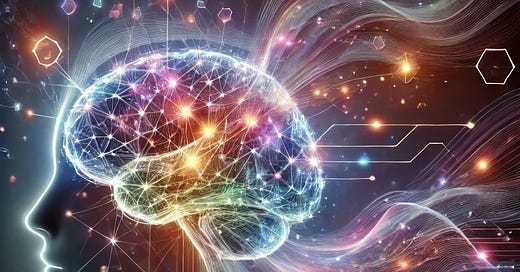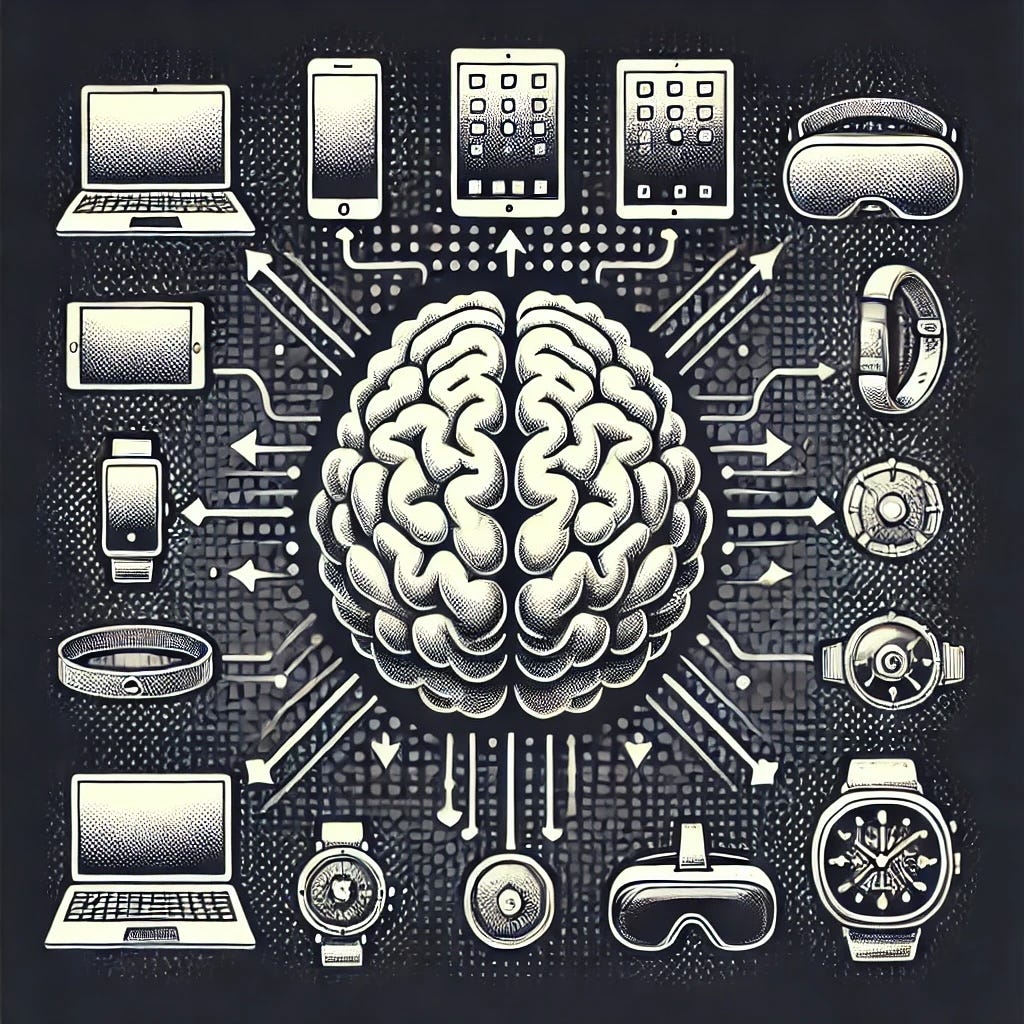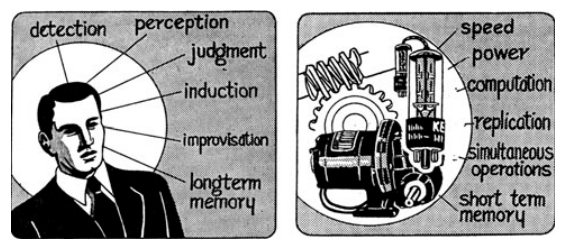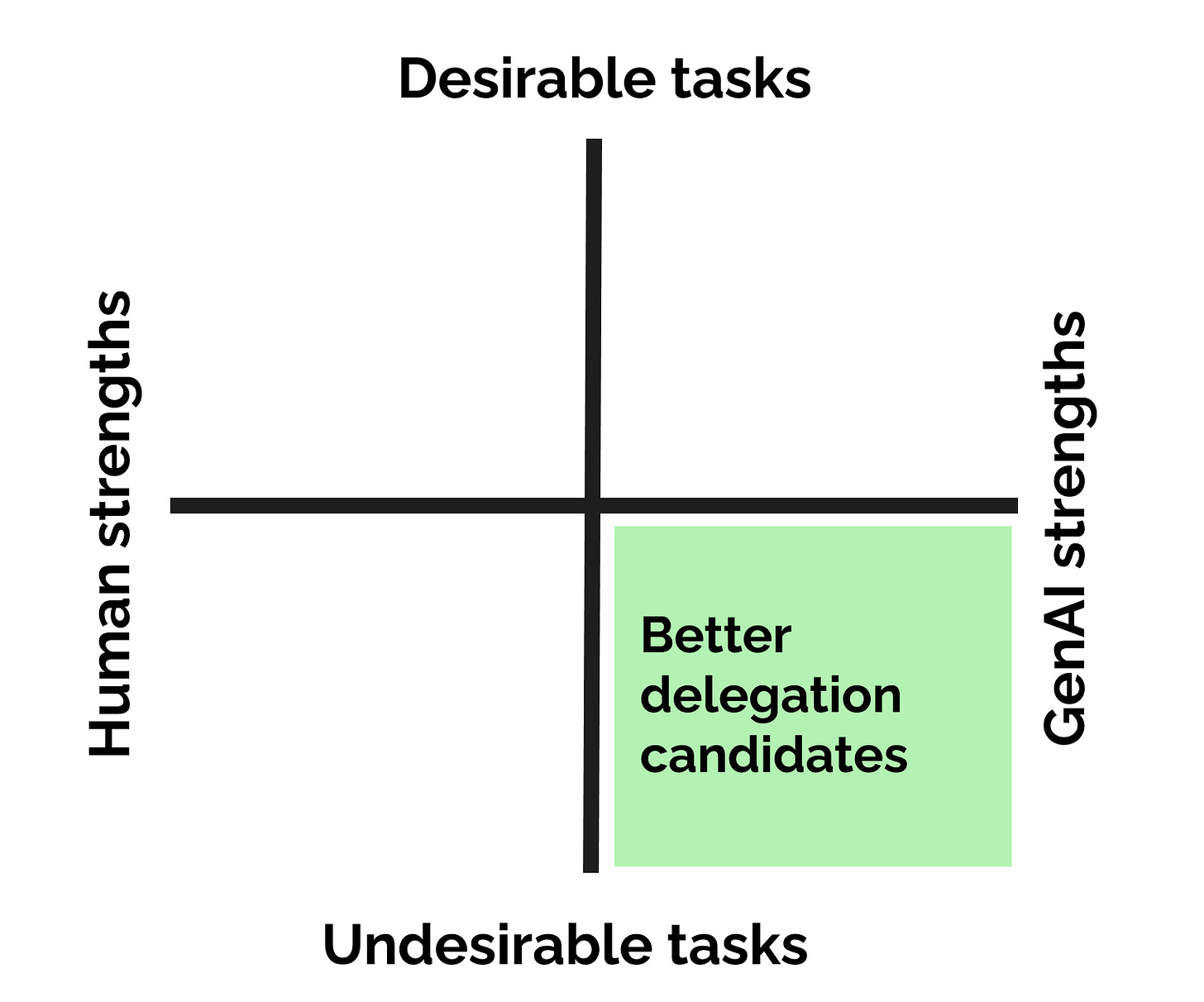Last week, I discussed why it’s crucial to build intuition about the strengths and limitations of generative AI (genAI). I shared five practical strategies to help you approach this intentionally and identify uses cases that genAI is best equipped to address. This Building GenAI Intuition guide is one tool from my Problem-Solution Symbiosis Framework
Today, I’m introducing another tool from the Framework: the Cognitive Offloading Matrix. This matrix helps product teams decide which tasks to delegate to genAI to create solutions that are useful, desirable, and designed to think with us, not for us. I’ll explain why cognitive offloading matters for genAI design, and walk you through to apply the Cognitive Offloading Matrix in practice.
Why Cognitive Offloading Matters for GenAI
GenAI enables us to delegate increasingly advanced “thinking tasks” to machines at an unprecedented rate. This delegation phenomenon is called cognitive offloading. For example: take away Google Maps, and I lose the ability to navigate even in a familiar city.
This concept ties into distributed cognition: that is, cognition isn’t confined to individual minds. Instead, it’s distributed across social groups, material environments - including technology tools! - and time. Returning to the Google Maps example: I have a mental representation of my destination, and distribute the ‘navigation’ part of cognition to Google Maps to get me there.
Cognitive offloading, and by extension distributed cognition, go into ‘10x mode’ with genAI. Today, we can summarize vast amounts of information, compose songs or generate an image using just a simple prompt. Looking ahead, the industry broadly agrees that Artificial General Intelligence (AGI) - roughly defined as “AI systems that are generally smarter than humans” - is inevitable. As OpenAI puts it, “as our systems get closer to AGI, we are becoming increasingly cautious with the creation and deployment of our models,” signaling AGI as a clear end goal.
How do we determine what to delegate to a genAI system and when? That’s where the Cognitive Offloading Matrix comes in.
Introducing The Cognitive Offloading Matrix
The Cognitive Offloading Matrix guides human-centered practitioners in evaluating which tasks people might want to delegate - or retain - when using genAI. While it’s relevant for today’s genAI solutions, it’s designed to remain applicable as AI capabilities evolve and move toward AGI.
This intentional approach to offloading matters for several reasons. Leveraging genAI to handle tasks people find tedious or challenging can lead to more valuable, desirable solutions that are more likely to be adopted. It puts centers people around genAI, rather than the other way around. This focus is especially important given public concerns about AI’s impact. In a recent survey , Americans were twice as likely to say AI does more harm than good (31%) as they are to believe the good of AI outweighs its harms (13%).
I’ll break down the different axes of the Cognitive Offloading Matrix and walk you through an example of how to apply it.
The “Strengths” Axis
The x-axis captures the comparative strengths of humans versus genAI, drawing inspiration from the Fitts List - a tool developed by psychologist and human factors researcher Paul Fitts in the early 1950s. Fitts identified specific areas where humans and machines excel differently. For example, humans are better at appropriately responding to low probability events (e.g., anticipating unusual behavior from pedestrians while driving), while machines outperform in detecting stimuli beyond human perception, such as infrared. The image below highlights tasks Fitts categorized as strengths for humans and machines.
You can apply this Fitts List approach to fill out your Strengths axis, tailored to your product domain and target audience. For example, if you're focused on building intensive care unit (ICU) solutions for healthcare workers and patients, AI systems excel at 24/7 monitoring and detecting movement anomalies (e.g., falls) in an ICU, while humans are better at providing care and support once an issue is detected.
For more inspiration:
Human Strengths: Refer to your organization’s existing customer research, and leverage secondary research on human behavior (e.g., peer-reviewed psychology and human-computer interaction articles found on Google Scholar).
GenAI Strengths: Draw from strengths you’ve identified from Building GenAI Intuition - another tool front the Problem-Solution Symbiosis Framework. Refer to Google’s People + AI Guidebook list, remembering to adapt the list based on the specific genAI tools you’re considering.
The “Tasks” Axis
The y-axis represents tasks your target audience performs to achieve a specific goal. For example, if your audience is industrial designers, their goal might be to create a concept render for a client. The tasks are the individual steps they take to complete this workflow. If your audience is people who use music streaming tools, their goal might be to create a custom playlist. The tasks are the individual steps in the process to create that playlist.
These examples highlight the need for a deep understanding of your target audience to accurately identify their tasks (e.g., through customer research). If you need to gather data, consider using contextual inquiry to learn how people navigate through a process or sequence in real-world settings.
Once you’ve identified the key tasks in a specific context (e.g., a given workflow), categorize them based on whether your audience finds these tasks enjoyable and meaningful (“desirable”) or would prefer not to do them (“undesirable”). This approach is inspired by research from Stanford, UT Austin, and Salesforce Research, which asked participants to rate on a scale of 1 to 10 how much they’d want a robot to take over a given activity. If you’re curious, washing floors ranked #1, while opening presents came in at #2090.
Matrix Mapping
With an understanding of Strengths and Tasks relevant to your product domain, you’re ready to start mapping to the Cognitive Offloading Matrix. You can take two approaches:
Task-first: Go through the steps of your target audience’s workflow or routine, assessing whether each step (i.e., task) is desirable or undesirable, and is a human or genAI strength.
Idea-first: Ideate on product ideas or features first. Identify which tasks they address in the user’s workflow or routine. Refer to the “task-first” approach.
The Sweet Spot of the Matrix is the bottom-right quadrant (highlighted in green below), where tasks are both undesirable for your audience and well-suited to leverage genAI’s unique strengths.
For tasks in other quadrants, carefully consider why your audience would find it valuable to offload them. Pay particular attention to the upper-right quadrant, where it’s tempting to offload something genAI can handle well. However, just because a task can be offloaded doesn’t mean it should be. Take an example from the robotics survey mentioned earlier: you could build a robot that’s excellent at unwrapping presents, but people don’t want to delegate this enjoyable activity.
Consider running a matrix mapping workshop with key stakeholders on your team. Ensure participants have a solid understanding of your target audience. Start by setting context at the beginning of the session. This collaborative approach encourages diverse perspectives (e.g., a machine learning engineer detailing genAI strengths) and fosters alignment across functions.
Music Streaming Example
Let’s see how the Cognitive Offloading Matrix can be applied to an example scenario.
Imagine you’re part of a team developing a music streaming product. Your company has recently committed to an AI-first strategy, so you’re exploring ways to integrate genAI into your features. You already have some insights into your target audience’s listening habits, preferences, and contexts (e.g., gathered through design research).
You start brainstorming feature ideas:
Idea 1: Offer a “generate playlist” button, followed by the option to directly share the playlist with loved ones.
Idea 2: Automatically adjust music recommendations based on context, like whether someone is driving or relaxing at home, and whether it’s morning or evening.
Let’s evaluate these ideas using the Cognitive Offloading Matrix.
For Idea 1, you AI could easily handle this task. However, you also have research shows that users enjoy creating playlists for loved ones. It's a desirable activity that leverages human strengths, such as making recommendations based on cultural nuances or unique connections. Automating this task would take away an experience users find meaningful. As-is, this idea falls into the upper right quadrant (desirable task x genAI strengths).

While you should certainly rethink pursuing this direction, consider if there is a seed of something valuable in the idea. Is there a way you might put users - rather than AI - in control of playlist creation? Refine how you might leverage AI, such as allowing the user to select parameters (e.g., new artists from your neighborhood). Emphasize an “Edit Playlist” option over an “Auto-Share” feature to maintain the user’s personal touch.
For Idea 2, you know dynamically tweaking music selections based on context aligns with genAI’s strengths in handling large-scale, real-time recommendations. Customers have expressed frustration when music suggestions don’t match their activities (e.g., recommending low-energy tracks during an early-morning drive). This is a clear opportunity for cognitive offloading that could enhance user satisfaction.
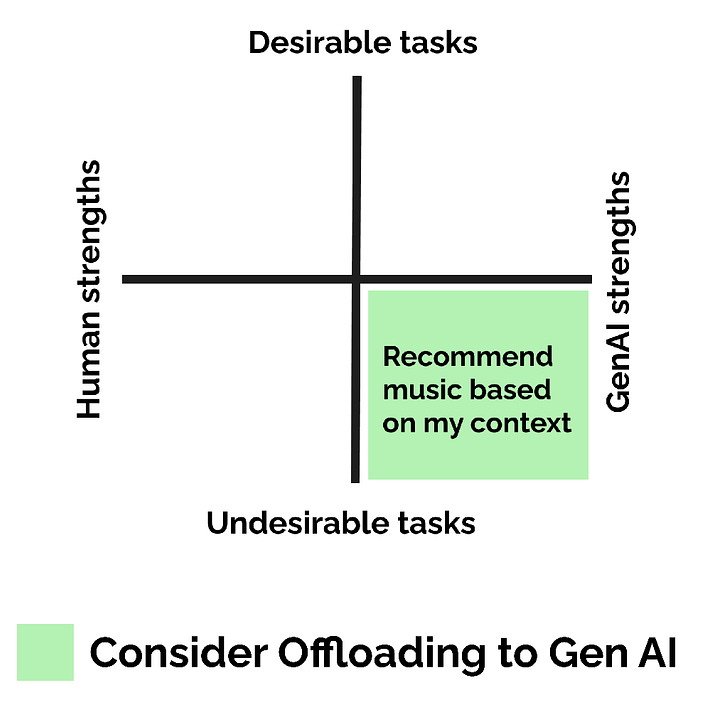
Not Just for Product Design
While we’ve demonstrated how the Cognitive Offloading Matrix can be used to identify and prioritize features, it can also guide marketing decisions.
In my recent EPIC talk, I highlighted an ad for the genAI tool Google Gemini that was pulled following public backlash. The ad featured a father using Gemini to help his daughter write a letter to her Olympic hero, Sydney McLaughlin-Levrone. Instead of freeing up time for genuine human interaction - such as writing a heartfelt letter together - the ad portrayed this meaningful activity as something to offload to AI. This isn’t to say genAI can never be useful when it comes to to scaffolding a first draft, or serving as a writing sparring partner. However, given the context of genAI’s application in this instance, offloading heartfelt letter-writing to genAI did not land with audiences.
Given the public’s concerns about AI use, those of us developing these technologies must be especially mindful of what aspects of human experience we depict as “offloadable” to genAI. The Cognitive Offloading Matrix can help with this. In the case of Google Gemini, “co-writing a heartfelt letter with your child” would fall into the red “Avoid Offloading to GenAI” quadrant.
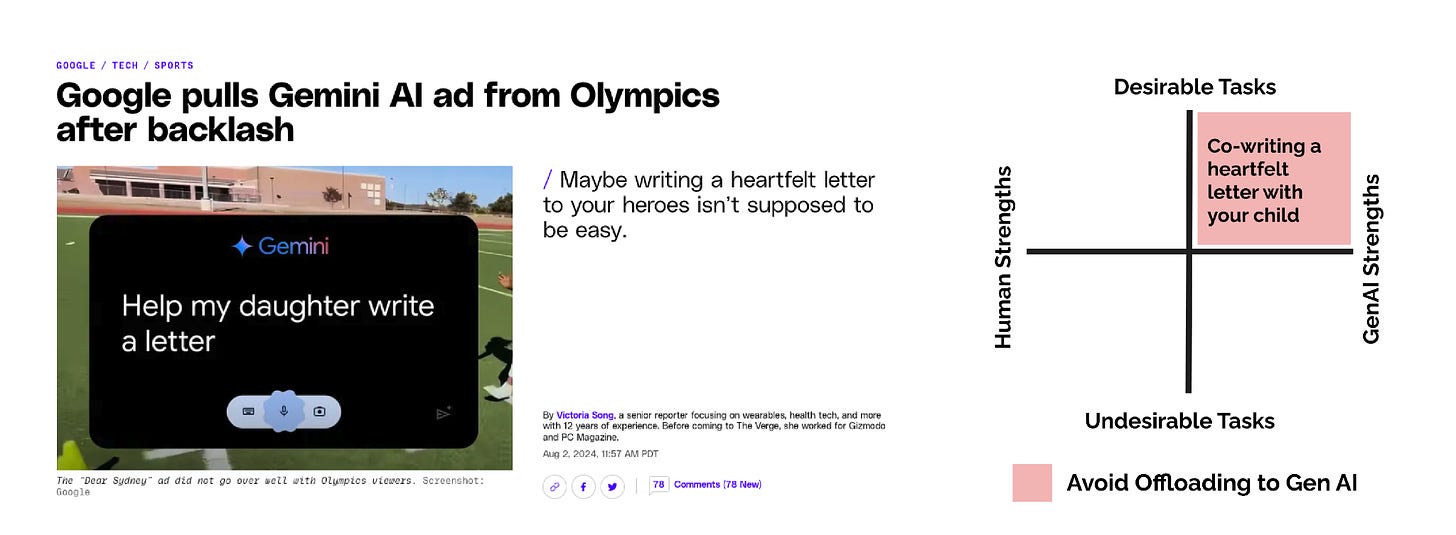
Discussions at EPIC also revealed opportunities to use the Cognitive Offloading Matrix for technology change management, to pinpoint where genAI can add the most value within teams. For instance, a design research team could playtest various genAI tools based on their goals and workflows, use the matrix to map which tasks they might offload, and evaluate how adopting these tools could influence their relationships within the stakeholder ecosystem.
Takeaways
GenAI enables 10x Cognitive Offloading
As genAI tools allow us to offload increasingly complex “thinking tasks,” it’s essential to be deliberate about what we choose to delegate to machines. This requires a deep understanding of both your target audience’s needs and the capabilities of the technology.
Cognitively Offload with Intention
Use the Cognitive Offloading Matrix to identify which parts of people’s workflows or routines are ideal for genAI delegation - and which should remain human-driven. Prioritize offloading tedious, mundane tasks that align with genAI’s strengths, while preserving meaningful activities that people enjoy or find valuable.
Applications in Product, Marketing, and Change Management
Given public concerns about AI, it’s crucial not only to develop products that thoughtfully offload cognition but also to showcase these tools being used for “Sweet Spot” tasks (i.e., bottom-right Matrix quadrant) in your marketing. Avoid promoting the use of AI for activities in the “danger quadrant” (i.e., upper-right) - tasks that AI could do well but people prefer to keep human. Additionally, consider using the matrix for change management, helping teams evaluate and integrate genAI tools in ways that complement their workflows and stakeholder relationships.
📣 Call to Action
Want to explore how the Cognitive Offloading Matrix can guide your product strategy, marketing, or digital transformation efforts? Let’s collaborate on a case study and uncover where genAI can add the most value. Reach out at stef@sendfull.com
The Cognitive Offloading Matrix: A How-To Guide © 2024 by Stefanie Hutka, Head of Design Research, Sendfull LLC is licensed under CC BY-SA 4.0
Human-Computer Interaction News
Meta introduces Orion Augmented Reality glasses: Meta introduced Orion, their long-awaited “true” AR glasses. With the Meta AI smart assistant running on the glasses, they can understand what you’re looking at in the physical world and provide visualizations. For example, open your refrigerator and ask for a recipe based on what’s inside.
Microsoft launches new Copilot capabilities: New capabilities including reading and analyzing what's on your screen, reasoning through complex problems, and responding with natural language.
How AlphaChip transformed computer chip design: DeepMind’s AlphaChip uses reinforcement learning to design optimized layouts for Google’s AI accelerator chips, reducing design time from months to hours. This development has the potential to transform chip design for custom hardware found in everyday devices such as smartphones, medical equipment, and agricultural sensors.

